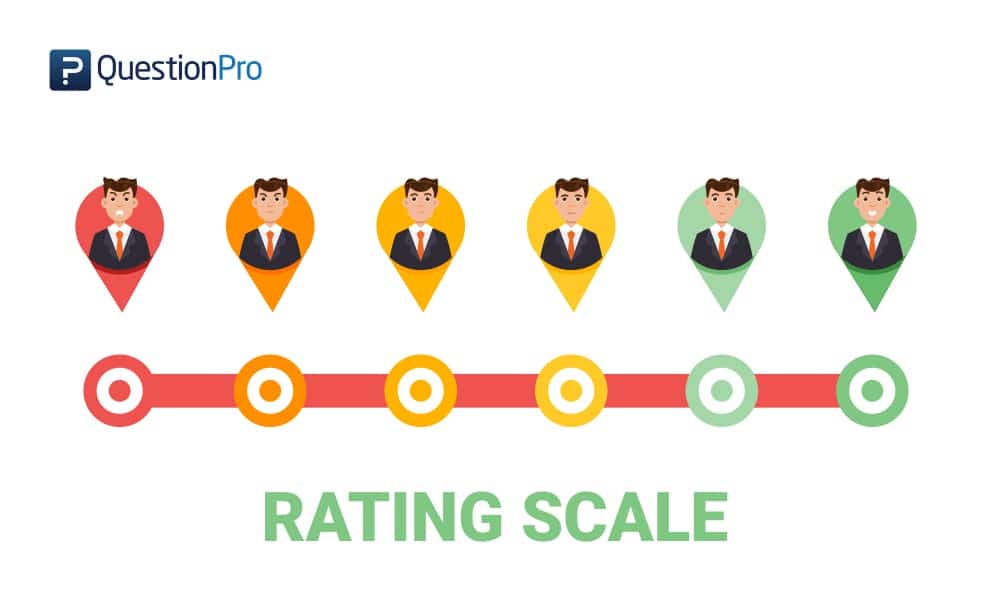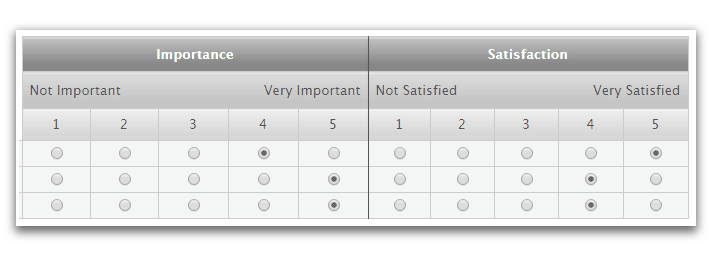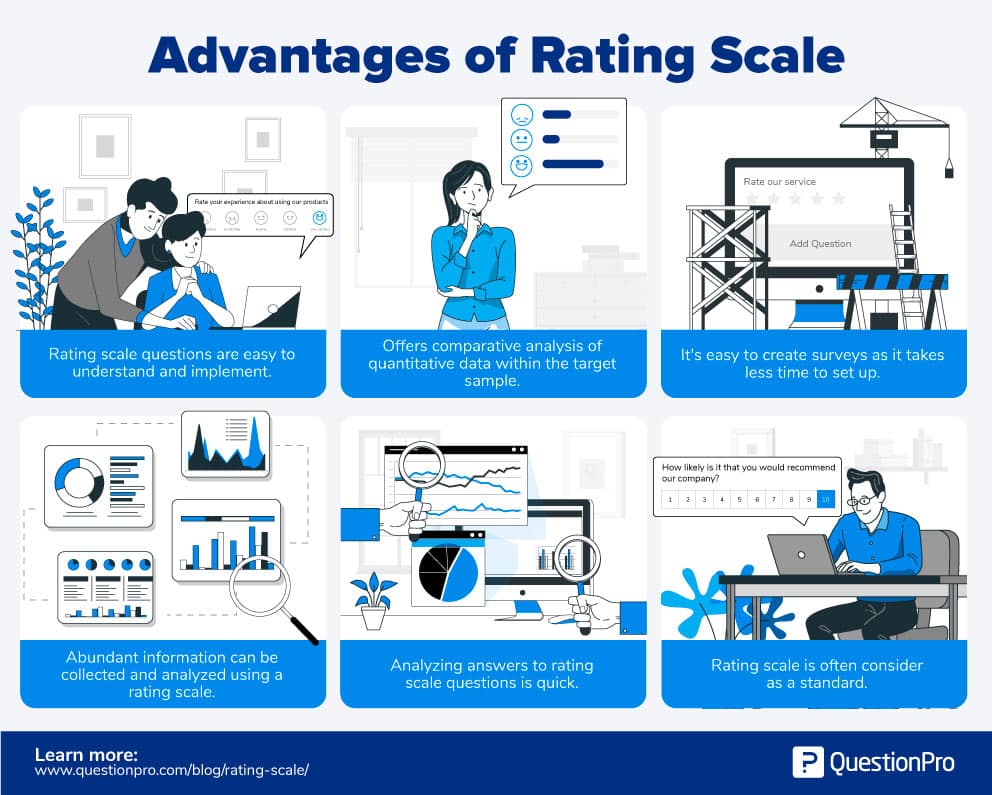Rating Scale: Definition, Survey Question Types and Examples

The rating scale is a closed-ended survey question used to represent respondent feedback in a comparative form for specific particular features/products/services. It is one of the most established question types for online and offline surveys where survey respondents are expected to rate an attribute or feature. The rating scale is a variant of the popular multiple-choice question , which is widely used to gather the information that provides relative information about a specific topic.
Researchers use a rating scale in research when they intend to associate a qualitative observation measure with the various aspects of a product or feature. Generally, this scale is used to evaluate the performance of a product or service, employee skills, customer service performances, customer-first strategy, processes followed for a particular goal, etc. A rating scale survey question can be compared to a checkbox question, but a rating scale provides more information than merely Yes/No.
4 Types of Rating Scale
Broadly speaking, rating scales can be divided into two categories: Ordinal and Interval Scales.
An ordinal scale is a scale that depicts the answer options in an ordered manner. The difference between the two answer option may not be calculable, but the answer options will always be in a certain innate order. Parameters such as attitude or feedback can be presented using an ordinal scale.
An interval scale is a scale where not only is the order of the answer variables established, but the magnitude of difference between each answer variable is also calculable. An absolute or true zero value is not present in an interval scale. The temperature in Celsius or Fahrenheit is the most popular example of an interval scale. Net Promoter Score , Likert Scale , and Bipolar Matrix Table are some of the most effective types of it.
Four primary types of rating scales can be suitably used in an online survey:
- Graphic
- Numerical
- Descriptive
- Comparative
- Graphic Rating Scale: It indicates the answer options on a scale of 1-3, 1-5, etc. Likert Scale is a popular graphic rating scale example. Respondents can select a particular option on a line or scale to depict rating. This rating scale is often implemented by HR managers to conduct employee evaluation .

- Numerical Rating Scale: It has numbers as answer options and not each number corresponds to a characteristic or meaning. For instance, a Visual Analog Scale or a Semantic Differential Scale can be presented using a numerical scale.


- Descriptive Rating Scale: In a descriptive scale, each answer option is elaborately explained to the respondents. A numerical value is not always related to the answer options in the descriptive scale. There are certain surveys, for example, a customer satisfaction survey , which need to describe all the answer options in detail so that every customer has thoroughly explained information about what is expected from the survey.
- Comparative Rating Scale: As the name suggests, it expects respondents to answer a particular question in terms of comparison, i.e. based on relative measurement or keeping other organizations/products/features as a reference.
Examples of Rating Scale Questions
Rating scale questions are widely used in customer satisfaction and employee satisfaction surveys to gather detailed information. Here are a few examples of these questions –
- Degree of Agreement: An organization intends to improve the efficiency of its employees. After organizing multiple courses and certifications for the employees, the management decides to survey whether employees resonate with the ideology behind these certifications. They can use a question such as the Even Likert Scale or Odd Likert Scale to evaluate the degree of agreement.

- Customer Experience: It is important to collect information about customer experience. It is important for organizations to gather real-time details about product or service purchase experiences. A rating scale question such as a Semantic Differential Scale can help the organization’s management to collect and analyze information about customer experience.
- Semantic Differential Scale

- Analyze brand loyalty: Organizations thrive on customer loyalty towards their brand. But brand loyalty is a factor that needs to be regularly monitored. Using a rating scale question such as Net Promoter Score can help organizations garner real-time details about customer loyalty and brand shareability. A rating question: “On a scale of 0-10, considering your purchasing experience, how likely are you to recommend our brand to your friends and colleagues?” can be effective in monitoring customer satisfaction and loyalty.

How To Write a Rating Scale Question
This short explainer video examines a popular rating scale and walks step by step through transforming the question until it aligns with best practices.
Its Uses
- Gain relative information about a particular subject: In a sample size of 1000 individuals, each individual will have a different outlook towards a topic. Gathering comparative information about satisfaction levels, the frequency of use, loyalty and many other such parameters.
- Compare and analyze data: Researchers can collect unbiased data from the target audience and analyze that using online survey softwares such as QuestionPro. If a rating scale question is used across a considerable sample size, there are chances that the margin of error in obtained data can be reduced or eliminated.
- Measure one important product/service element: There are surveys where certain topics need to be addressed specifically, in order to understand the target market in a better manner. Rating scales can be implemented in such cases where there are multiple important elements which are to be analyzed. For instance, to measure degree of agreement, frequency, satisfaction etc.
Advantages

- Rating scale questions are easy to understand and implement.
- Offers a comparative analysis of quantitative data within the target sample for researchers to make well-informed decisions.
- Using graphic rating scales, it is easy for researchers to create surveys as they consume the least time to configure.
- Abundant information can be collected and analyzed using a rating scale.
- The analysis of answer received for rating scale questions is quick and less time-consuming.
- Rating scale is often considered to a standard for collecting qualitative and quantitative information for research.
Rating Scales in Template Libraries
QuestionPro provides various types of rating scales to help you determine how a particular respondent feels about a certain issue. There are several ways a user can create a survey that utilizes rating scales, including selecting from a pre-made template, importing an existing survey, or creating a brand-new survey.
Template Library
The template library in QuestionPro provides over 100 templates, each one customizable, so you can determine whichever rating scale fits your needs. Before you sit down and choose the type of survey you wish to conduct, it’s always best to think ahead and determine what kind of data you wish to receive. If you’re new to survey creation and not sure which types of rating scales you need, go ahead and check out QuestionPro’s vast template library to help you begin brainstorming.
Importing & Copying Surveys
Another option for those who already use QuestionPro is importing an existing survey. This allows you to take the ideas and flow of a previously built survey and either reuse it or edit it. In addition, you can always use Microsoft™ Word™ to create a survey to import, which you can then edit and implement the rating scales you need. This works out really well if one particular user administers a survey with certain rating scales who is not the author of that survey.
Doing a Survey from Scratch
If neither of those options fits your needs, you can always create a survey from scratch and add the rating scales you wish to fit your requirements. Apart from the intuitive interface, QuestionPro will provide you with various question types to choose from and whichever rating scales you need for collecting the necessary data.









